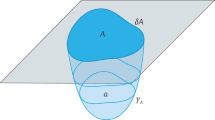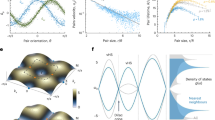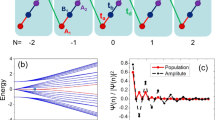Abstract
Holographic quantum matter exhibits an intriguing connection between quantum black holes and more conventional (albeit strongly interacting) quantum many-body systems. This connection is manifested in the study of their thermodynamics, statistical mechanics and many-body quantum chaos. In this Review, we discuss these connections, focusing on the most promising example of holographic quantum systems to date – the family of Sachdev–Ye–Kitaev (SYK) models. The SYK models are simple quantum mechanical models that have the potential to holographically realize quantum black holes. We examine various proposals for the experimental realizations of SYK models, including ultracold gases, graphene flakes, semiconductor quantum wires and 3D topological insulators. These approaches offer the exciting prospect of accessing black hole physics and thus addressing many important questions regarding quantum gravity in the laboratory.
This is a preview of subscription content, access via your institution
Access options
Access Nature and 54 other Nature Portfolio journals
Get Nature+, our best-value online-access subscription
$29.99 / 30 days
cancel any time
Subscribe to this journal
Receive 12 digital issues and online access to articles
$119.00 per year
only $9.92 per issue
Buy this article
- Purchase on Springer Link
- Instant access to full article PDF
Prices may be subject to local taxes which are calculated during checkout






Similar content being viewed by others
References
Hawking, S. W. Breakdown of predictability in gravitational collapse. Phys. Rev. D. 14, 2460–2473 (1976).
Almheiri, A., Marolf, D., Polchinski, J. & Sully, J. Black holes: complementarity or firewalls?. J. High Energy Phys. 2013, 62 (2013).
Susskind, L. The world as a hologram. J. Math. Phys. 36, 6377–6396 (1995).
Hooft, G. in Basics and Highlights in Fundamental Physics Vol. 37 (ed. Zichichi, A.) 72−100 (World Scientific, 2001).
Hartnoll, S. A., Lucas, A. & Sachdev, S. Holographic quantum matter. Preprint at https://arxiv.org/abs/1612.07324 (2016).
Sachdev, S. & Ye, J. Gapless spin-liquid ground state in a random quantum Heisenberg magnet. Phys. Rev. Lett. 70, 3339–3342 (1993).
Kitaev, A. A simple model of quantum holography. in KITP Strings Seminar and Entanglement 2015 Program (2015).
Maldacena, J. & Stanford, D. Remarks on the Sachdev-Ye-Kitaev model. Phys. Rev. D. 94, 106002 (2016).
Hawking, S. W. Particle creation by black holes. Commun. Math. Phys. 43, 199–220 (1975).[,167(1975)].
Bekenstein, J. D. Black holes and entropy. Phys. Rev. D 7, 2333–2346 (1973).
Bardeen, J. M. M., Carter, B. & Hawking, S. W. W. The four laws of black hole mechanics. Commun. Math. Phys. 31, 161–170 (1973).
Andrew Strominger, A. & Vafa, C. Microscopic origin of the Bekenstein — Hawking entropy. Phys. Lett. B 79, 99–104 (1996).
Shenker, S. H. & Stanford, D. Black holes and the buttery effect. J. High Energy Phys. 2014, 6767 (2014).
Swingle, B., Bentsen, G., Schleier-Smith, M. & Hayden, P. Measuring the scrambling of quantum information. Phys. Rev. A 94, 040302 (2016).
Lieb, E. H. & Robinson, D. W. The finite group velocity of quantum spin systems. Commun. Math. Phys. 28, 251–257 (1972).
Kovtun, P. Son D. T. & Starinets A. O. Viscosity in strongly interacting quantum field theories from black hole physics Phys. Rev. Lett. 94 111601 2005.
Maldacena, J., Shenker, S. H. & Stanford, D. A bound on chaos. J. High Energy Phys. 2016, 106 (2016).
Majorana, E. Teoria simmetrica dell’elettrone e del positrone. Nuovo Cimento 5, 171 (1937). Engl. Transl.: Soryushiron Kenkyu 63, 149 (1981).
Wilczek, F. Majorana returns. Nat. Phys. 5, 614–618 (2009).
Alicea, J. New directions in the pursuit of majorana fermions in solid state systems. Rep. Prog. Phys. 75, 076501 (2012).
Beenakker, C. W. J. Search for majorana fermions in superconductors. Annu. Rev. Condens. Matter Phys. 4, 113 (2013).
Leijnse, M. & Flensberg, K. Introduction to topological superconductivity and majorana fermions. Semicond. Sci. Technol. 27, 124003 (2012).
Stanescu, T. D. & Tewari, S. Majorana fermions in semiconductor nanowires: fundamentals, modeling, and experiment. J. Phys. Condens. Matter 25, 233201 (2013).
Elliott, S. R. & Franz, M. Colloquium: majorana fermions in nuclear, particle, and solid-state physics. Rev. Mod. Phys. 87, 137–163 (2015).
Mourik, V., Zuo, K., Frolov, S. M., Plissard, S. R., Bakkers, E. P. M. et al. Signatures of majorana fermions in hybrid superconductor-semiconductor nanowire devices. Science 336, 1003–1007 (2012).
Das, A., Ronen, Y., Most, Y., Oreg, Y., Heiblum, M. et al. Zero-bias peaks and splitting in an Al-InAs nanowire topological superconductor as a signature of majorana fermions. Nat. Phys. 8, 887 (2012).
Deng, M. T., Yu, C. L., Huang, G. Y., Larsson, M., Caroff, P. et al. Anomalous zero-bias conductance peak in a Nb–In–Sb nanowire–Nb hybrid device. Nano Lett. 12, 6414–6419 (2012).
Rokhinson, L. P., Liu, X. & Furdyna, J. K. The fractional a.c. Josephson effect in a semiconductor–superconductor nanowire as a signature of Majorana particles. Nat. Phys. 8, 795–799 (2012).
Finck, A. D. K., Van Harlingen, D. J., Mohseni, P. K., Jung, K. & Li, X. Anomalous modulation of a zero-bias peak in a hybrid nanowire-superconductor device. Phys. Rev. Lett. 110, 126406 (2013).
Hart, S., Ren, H., Wagner, T., Leubner, P., Mühlbauer, M. et al. Induced superconductivity in the quantum spin hall edge. Nat. Phys. 10, 638–643 (2014).
Nadj-Perge, S., Drozdov, I. K., Li, J., Chen, H., Jeon, S. et al. Observation of majorana fermions in ferromagnetic atomic chains on a superconductor. Science 346, 602–607 (2014).
Xu, J.-P., Wang, M.-X., Liu, Z. L., Ge, J.-F., Yang, X. et al. Experimental detection of a majorana mode in the core of a magnetic vortex inside a topological insulator superconductor Bi2Te3/NbSe2 heterostructure. Phys. Rev. Lett. 114, 017001 (2015).
Sun, H.-H., Zhang, K.-W., Hu, L.-H., Li, C., Wang, G.-Y. et al. Majorana zero mode detected with spin selective Andreev reection in the vortex of a topological superconductor. Phys. Rev. Lett. 116, 257003 (2016).
French, J. B. & Wong, S. S. M. Validity of random matrix theories for many-particle systems. Phys. Lett. B 33, 449–452 (1970).
Bohigas, O. & Flores, J. Two-body random hamiltonian and level density. Phys. Lett. B 34, 261–263 (1971).
Bohigas, O. & Flores, J. Spacing and individual eigenvalue distributions of two-body random hamiltonians. Phys. Lett. B 35, 383–386 (1971).
You, Y.-Z., Ludwig, A. W. W. & Xu, C. Sachdev-Ye-Kitaev model and thermalization on the boundary of many-body localized fermionic symmetry-protected topological states. Phys. Rev. B 95, 115150 (2017).
Polchinski, J. & Rosenhaus, V. The spectrum in the Sachdev-Ye-Kitaev model. J. High Energy Phys. 2016, 1 (2016).
García-García, A. M. & Verbaarschot, J. J. M. Spectral and thermodynamic properties of the Sachdev-Ye-Kitaev model. Phys. Rev. D. 94, 126010 (2016).
Fu, W., Gaiotto, D., Maldacena, J. & Sachdev, S. Supersymmetric Sachdev-Ye-Kitaev models. Phys. Rev. D. 95, 026009 (2017).
Banerjee, S. & Altman, E. Solvable model for a dynamical quantum phase transition from fast to slow scrambling. Phys. Rev. B 95, 134302 (2017).
Bi, Z., Jian, C.-M., You, Y.-Z., Pawlak, K. A. & Xu, C. Instability of the non-Fermi-liquid state of the Sachdev-Ye-Kitaev model. Phys. Rev. B 95, 205105 (2017).
Lantagne-Hurtubise, É., Li, C. & Franz, M. Family of Sachdev-Ye-Kitaev models motivated by experimental considerations. Phys. Rev. B 97, 235124 (2018).
Gu, Y., Qi, X.-L. & Stanford, D. Local criticality, diffusion and chaos in generalized Sachdev-Ye-Kitaev models. J. High Energy Phys. 2017, 125 (2017).
Berkooz, M., Narayan, P., Rozali, M. & Simón, J. Higher dimensional generalizations of the syk model. J. High Energy Phys. 2017, 138 (2017).
Hosur, P., Qi, X.-L., Roberts, D. A. & Yoshida, B. Chaos in quantum channels. J. High Energy Phys. 2016, 4 (2016).
Liu, C., Chen, X. & Balents, L. Quantum entanglement of the Sachdev-Ye-Kitaev models. Preprint at https://arxiv.org/abs/1709.06259 (2017).
Huang, Y. & Gu, Y. Eigenstate entanglement in the Sachdev-Ye-Kitaev model. Preprint at https://arxiv.org/abs/1709.09160 (2017).
Gu, Y., Qi, X.-L. & Stanford, D. Local criticality, diffusion and chaos in generalized Sachdev-Ye-Kitaev models. J. High Energy Phys. 2017, 125 (2017).
Davison, R. A., Fu, W., Georges, A., Gu, Y., Jensen, K. & Sachdev, S. Thermoelectric transport in disordered metals without quasiparticles: The Sachdev-Ye-Kitaev models and holography. Phys. Rev. B 95, 155131 (2017).
Song, X.-Y., Jian, C.-M. & Balents, L. Strongly correlated metal built from Sachdev-Ye-Kitaev models. Phys. Rev. Lett. 119, 216601 (2017).
Pengfei, Z. Dispersive Sachdev-Ye-Kitaev model: band structure and quantum chaos. Phys. Rev. B 96, 205138 (2017).
Patel, A. A., McGreevy, J., Arovas, D. P. & Sachdev, S. Magnetotransport in a model of a disordered strange metal. Phys. Rev. X 8, 021049 (2018).
Chowdhury, D., Werman, Y., Berg, E. & Senthil, T. Translationally invariant non-fermi-liquid metals with critical fermi surfaces: solvable models. Phys. Rev. X 8, 031024 (2018).
Patel, A. A., Lawler, M. J. & Kim, E. A coherent superconductivity with large gap ratio from incoherent metals. Preprint at https://arxiv.org/abs/1805.11098 (2018).
Wu, X., Chen, X., Jian, C.-M., You, Y.-Z. & Xu, C. A candidate theory for the "strange metal" phase at finite energy window. Preprint at https://arxiv.org/abs/1802.04293 (2018).
García-Álvarez, L., Egusquiza, I. L., Lamata, L., del Campo, A., Sonner, J. & Solano, E. Digital quantum simulation of minimal AdS/CFT. Phys. Rev. Lett. 119, 040501 (2017).
Luo, Z., You, Y.-Z., Li, J., Jian, C.-M. & Lu, D. et al. Observing fermion pair instability of the Sachdev-Ye-Kitaev model on a quatum spin simulator. Preprint at https://arxiv.org/abs/1712.06458. (2017).
Sachdev, S. Bekenstein-Hawking entropy and strange metals. Phys. Rev. X 5, 041025 (2015).
Greiner, M., Mandel, O., Esslinger, T., Hänsch, T. W. & Bloch, I. Quantum phase transition from a superuid to a mott insulator in a gas of ultracold atoms. Nature 415, 39–44 (2002).
Jotzu, G., Messer, M., Desbuguois, R., Lebrat, M. & Uehlinger, T. et al. Experimental realization of the topological Haldane model with ultracold fermions. Nature 515, 237–240 (2014).
Danshita, I., Hanada, M. & Tezuka, M. Creating and probing the sachdevyekitaev model with ultracold gases: Towards experimental studies of quantum gravity. Progress. Theor. Exp. Phys. 2017, 083I01 (2017).
Danshita, I., Hanada, M. & Tezuka, M. How to make a quantum black hole with ultra-cold gases. Preprint at https://arxiv.org/abs/1709.07189 (2017).
Gärttner, M., Bohnet, J. G. & Safavi-Naini, A., Wall, M. L., Bollinger, J. J. et al. Measuring out-of-time-order correlations and multiple quantum spectra in a trapped ion quantum magnet. Preprint at https://arxiv.org/abs/1608.08938. (2017).
Li, J., Fan, R., Wang, H., Ye, B., Zeng, B. & et al. Measuring out-of-time-order correlators on a nuclear magnetic resonance quantum simulator. Phys. Rev. X 7, 031011 (2017).
Chen, A., Ilan, R., de Juan, F., Pikulin, D. I. & Franz, M. Quantum holography in a graphene ake with an irregular boundary. Phys. Rev. Lett. 121, 036403 (2018).
Tsui, D. C., Stormer, H. L. & Gossard, A. C. Two-dimensional magnetotransport in the extreme quantum limit. Phys. Rev. Lett. 48, 1559–1562 (1982).
Laughlin, R. B. Anomalous quantum hall effect: An incompressible quantum uid with fractionally charged excitations. Phys. Rev. Lett. 50, 1395–1398 (1983).
Arovas, D., Schrieffer, J. R. & Wilczek, F. Fractional statistics and the quantum hall effect. Phys. Rev. Lett. 53, 722–723 (1984).
Castro Neto, A. H., Guinea, F., Peres, N. M. R., Novoselov, K. S. & Geim, A. K. The electronic properties of graphene. Rev. Mod. Phys. 81, 109–162 (2009).
Aharonov, Y. & Casher, A. Ground state of a spin-1/2 charged particle in a two-dimensional magnetic field. Phys. Rev. A 19, 2461–2462 (1979).
Can, O., Nica, E. M. & Franz, M. Charge transport in graphene-based mesoscopic realizations of Sachdev-Ye-Kitaev models. Preprint at https://arxiv.org/abs/1808.06584 (2018).
Oreg, Y., Refael, G. & Oppen, F. Helical liquids and majorana bound states in quantum wires. Phys. Rev. Lett. 105, 177002 (2010).
Lutchyn, R. M., Sau, J. D. & Sarma, S. D. Majorana fermions and a topological phase transition in semiconductor-superconductor heterostructures. Phys. Rev. Lett. 105, 077001 (2010).
Chew, A., Essin, A. & Alicea, J. Approximating the sachdev-ye-kitaev model with majorana wires. Phys. Rev. B 96, 121119 (2017).
Fu, L. & Kane, C. L. Superconducting proximity effect and majorana fermions at the surface of a topological insulator. Phys. Rev. Lett. 100, 096407 (2008).
Pikulin, D. I. & Franz, M. Black hole on a chip: proposal for a physical realization of the Sachdev-Ye-Kitaev model in a solid-state system. Phys. Rev. X 7, 031006 (2017).
Teo, J. C. Y. & Kane, C. L. Topological defects and gapless modes in insulators and superconductors. Phys. Rev. B 82, 115120 (2010).
Anderson, P. W. More is different. Science 177, 393–396 (1972).
Cotler, J. S. & Gur-Ari, G. & Hanada, M. & Polchinski, J. & Saad, P. et al. Black holes and random matrices. J. High Energy Phys. 2017, 118 (2017).
Maldacena, J., Stanford, D. & Yang, Z. Diving into traversable wormholes. Fortsch. Phys. 65, 1700034 (2017).
Kourkoulou, I. & Maldacena, J. Pure states in the SYK model and nearly-AdS2 gravity. Preprint at https://arxiv.org/abs/1707.02325 (2017).
Maldacena, J. & Qi, X.-L. Eternal traversable wormhole. Preprint at https://arxiv.org/abs/1804.00491 (2018).
Dirac, P. A. M. The quantum theory of the electron. Proc. R. Soc. A 117, 610 (1928).
Kitaev, A. Y. Unpaired Majorana fermions in quantum wires. Phys. Usp. 44, 131 (2001).
Sherrington, D. & Kirkpatrick, S. Solvable model of a spin-glass. Phys. Rev. Lett. 35, 1792–1796 (1975).
Sachdev, S. Holographic metals and the fractionalized Fermi liquid. Phys. Rev. Lett. 105, 151602 (2010).
Nayak, P., Shukla, A., Soni, R. M., Trivedi, S. P. & Vishal, V. On the dynamics of near-extremal black holes. J. High Energy Phys. 2018, 48 (2018).
Maldacena, J., Stanford, D. & Yang, Z. Conformal symmetry and its breaking in two-dimensional nearly anti-de Sitter space. Prog. Theor. Exp. Phys. 2016, 12C104 (2016).
Acknowledgements
The authors are indebted to many colleagues who helped shape their understanding of the subject. Of these, special thanks go to I. Affleck, E. Altman, J. Alicea, L. Balents, M. Berkooz, A. Chen, F. Haehl, A. Kitaev, C. Li, E. Lantagne-Hurtubise, P. Narayan, D. Pikulin, S. Sachdev, J. Simon and M. Tezuka.
Author information
Authors and Affiliations
Contributions
Both authors contributed equally to this work.
Corresponding author
Ethics declarations
Competing interests
The authors declare no competing interests.
Additional information
Publisher’s note
Springer Nature remains neutral with regard to jurisdictional claims in published maps and institutional affiliations.
Rights and permissions
About this article
Cite this article
Franz, M., Rozali, M. Mimicking black hole event horizons in atomic and solid-state systems. Nat Rev Mater 3, 491–501 (2018). https://doi.org/10.1038/s41578-018-0058-z
Published:
Issue Date:
DOI: https://doi.org/10.1038/s41578-018-0058-z
This article is cited by
-
Causal structure of interacting Weyl fermions in condensed matter systems
Nature Communications (2023)
-
Scrambling and quantum teleportation
Quantum Information Processing (2023)
-
A topological kagome magnet in high entropy form
Communications Physics (2022)
-
Topological materials discovery from crystal symmetry
Nature Reviews Materials (2021)
-
Quantum many-body physics from a gravitational lens
Nature Reviews Physics (2020)



